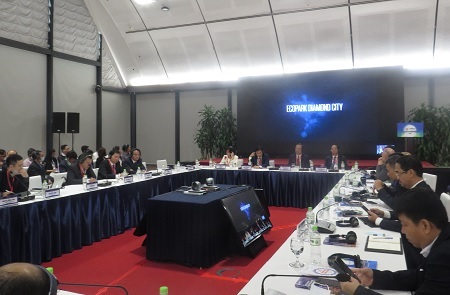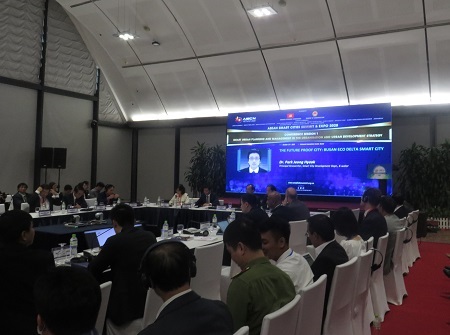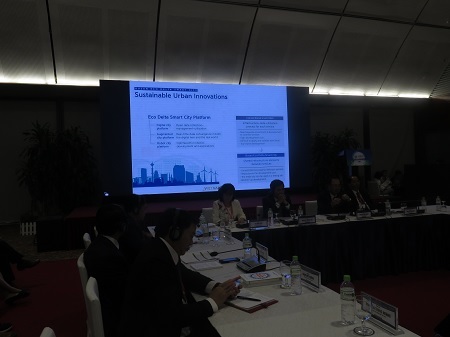The Research results around the world indicated that: six main factors related to smart cities as follows:
1. Smart citizens
2. Smart traffic and transportation
3. Smart environment
4. Smart economy
5. Smart governance
6. Smart life

Group Photo of Confrence Session 1: Smart Urban Planning and Management in the Urbanisation and Urban Development Stategy under ASEAN Smart City Summit and Expo 2020 ( photo by VISTIP)
For each specific factor mentioned above, cities will concretize goals to define their goals and action plans to achieve the identified goals.
1. Smart citizen: is the continual improvement in the capacity and qualifications of citzen through continuous improvements in the qualifications of citizen in all stages of their life and career. That is the end result of the quality of human resources and the labor market associated with the quality of citizens life. Any citizen living in a smart city also wants to develop an adaptive and flexible labor market in order to respond to the rapidly changing labor demand of society, with a growing education system, lifelong learning. Smart citizens also contribute to social development by promoting socio-economic dialogue, participation in social activities, public life, social interactions, using potential. and creative of cultural, sports and tourism infrastructure for their development.
2. Smart traffic/transportation: Increasing technology application to solve the optimization issues of public transport, providing public utilities for users in smart cities. Towards empowering citizens with faster, cheaper and environmentally friendly mobility through improving the provision of optimal access to traffic and travelling information; building transport systems in general and public transport in particular to meet all the needs of citizens, directing citizens towards environmentally & friendly transport systems. For this reason, they had implemented the solutions have been given to better provide and manage multimedia transport networks and improve connectivity, quality of the public transport system. Transportation by all modes of transport will be best facilitated, reducing traffic congestion, increasing transit capacity in city and reducing toxic emissions that will have the green house effect.
3. Smart environment: Towards the goal of maintaining balance in the ecosystem. This requires effective and comprehensive management of environmental resources, the proper use of natural resources, and the development of skills to prevent and mitigate negative environmental impacts to economic activities. Environment-smart also means: ensuring the ecological security of social infrastructure and its people by improving the quality of the environment, continuously protecting natural resources, landscape values, preserve and recover degraded ecosystems. Environment-smart also adapts to climate change, implementing solutions to reduce greenhouse gas emissions, increasing investment in research and technology development related to energy efficiency and safety. to ensure energy and fuel security, develop renewable energy sources and reduce the environmental impact of energy emissions. Smart city is closely linked with the concept of ecological city, which is the main concept of green city.
4. Smart Economy: Understood as an economy based on innovation, entrepreneurial spirit, high productivity, flexibility with the labor market, open to international and inter-regional cooperation, having ability to chang. In other words, according to the smart economy approach, a new knowledge-based economy, in which the driving force of development is innovation and modern information technology that includes: global competition, innovation technology and continuous organizational improvement.
5. Smart Governance: Understood as intelligent management and public services, the city authority take important priorities for citizens participation in decision-making and transparency of actions for quality and availability of public services. Smart governance is the process of finding a growing balance between environmental requirements, social pressures to improve quality of life, and available solutions in localties level.
6. Smart life: Understand as an attempt to create an efficient system of high-quality public spaces in urban area. Attractively and friendly urban space for every one, harmonious combination of different themes and styles. To enrich and diverse urban land cape, but we heve to form a coherent and unified plan. Smart life is tied to the striving to build local public space systems that are used to perform social function, such as: medical, cultural, sports, and entertainment. One of the goals of smart life is to create a safety and friendly space for vulnerable people in urban with cleaner air and water, more green trees areas and parks with high-quality buildings that close with citizens and facilitating energy-efficient using .
In summary the six main pillars discussed by the experts and according to the research results are aimed at bringing a better life to the citizens, sometimes the means to achieve this goal also helps the city move toward other goals. For example, reducing greenhouse gas emissions and pollution can be done by using energy more intelligent, efficient Improving the quality of human resources and the knowledge of citizens at the same time contributing to setting up other smart systems. The setting up smart city therfore requires a smart approach.
What is the lesson for choosing the priority pillars for smart city?
In fact, there aren't many cities implementing all of the pillars for their action plans at the same time because of capital issues, each city's priorities, as well as the consistency of the pillars. In the world, there are only a few cities built that can fully deploy the entire pillars of smart cities at the same time, but not really effective and meet the scale of construction due to the standard of living and immigrant residents cannot really meet the cost of maintaining a smart city if the investment is synchronous, for example, the case of SONGDO in Korea.

Expert from K- Water shared detail information about Smart city Development project in Busan – Korea (photo by VISTIP)

Expert and participants have discussed the topic “Sustainable Urban Innovations “ at one sientific conference of the ASEAN Smart City Summit and Expo 2020 (photo by VISTIP)
Technologies will not make the city smarter if it does not match the living standards and needs of residents, authorities, customers as well as the end users. Therefore, when determining the principles of approaching to build a smart city today, it is increasingly based on the needs of citizens. The basic approach is to offer smart services to serve the needs of the citzens and their income, listening to citizens opinions about these services in order to continuously improve service quality. Based on citizens needs in the short, medium, and long term, the cities authorities define their goals when building smart cities mentioned above. After determining the important pillars for building a smart city we should deploy in order of priority. To do this, we have to pay attention to the following issues:
a) There are several main pillars for building smart cities. Determining which infrastructure pillars should be tied to one of the main pillars, a smart infrastructure option can contribute to one or more goals with urban smart building activities of the city authorities.
b) The selection of the priority pillars to build the smart city must be based on the priority order and the feasibility of technology, finance and human resources.
c) After being selected, it is necessary to deploy the smart infrastructure project on a small scale first if it is successful and gain new deployment practical experience, we will implement them with broader scale for the whole city or inner area of the city.
d) It is not necessary to limit the goals of building a smart city to a certain pillar of smart infrastructure, but it is completely possible to define a target associated with a few smart infrastructure pillars to be able to build a synchronous intelligent system to achieve this goal.
e) The set goals of smart projects in smart cities must be in line with general development goals of the city, which are set out in the socio-economic development plan as well as in architectural and constructional plans of local authorities.
(Summing up from ASEAN Smart City Summit and Expo 2020 “Building and developing smart cities: International experiences and lessons for Vietnam”)